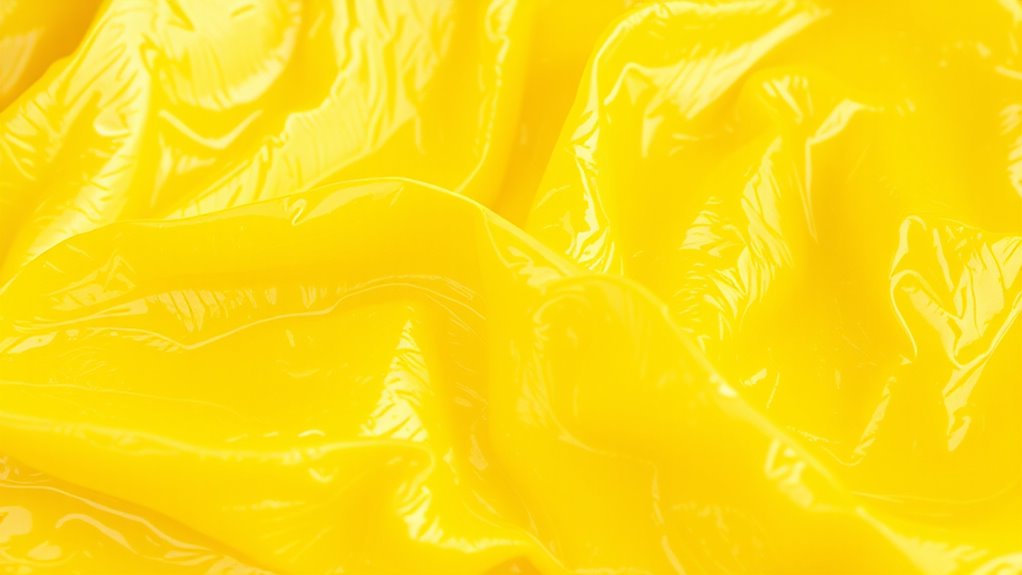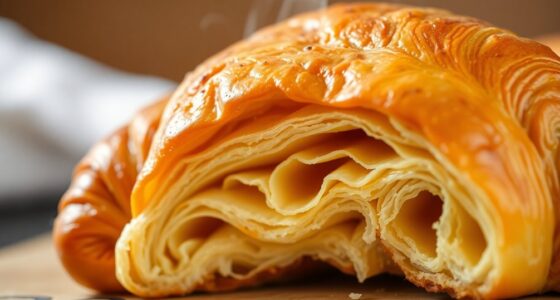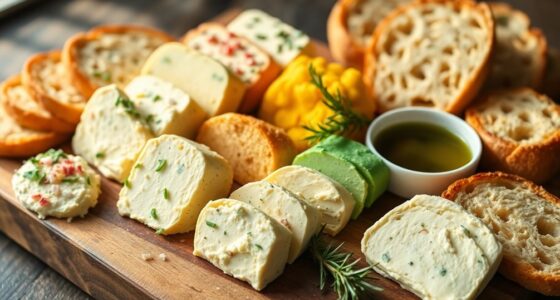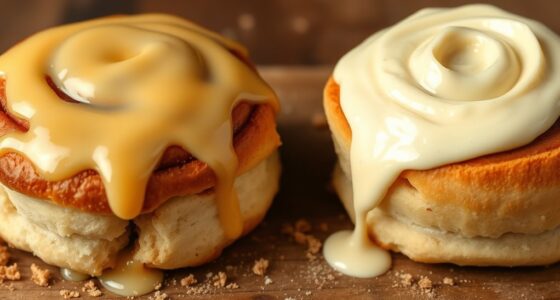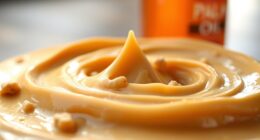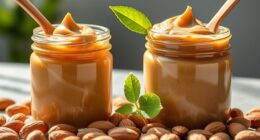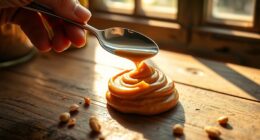Vegan “butters” have improved considerably, now closely mimicking the texture and flakiness of traditional butter. By carefully selecting plant-based fats, maintaining proper temperature, and mastering lamination techniques like folding and chilling, you can achieve layered, flaky layers similar to classic pastries. While it takes practice to perfect these skills, consistent effort and ingredient choices make matching the traditional texture possible. Keep exploring, and you’ll discover how to create professional-quality vegan laminates that rival their dairy counterparts.
Key Takeaways
- Proper cold vegan butter and dough handling are essential for distinct, flaky layers.
- Using high-quality plant-based fats like coconut or sunflower oil helps mimic traditional butter’s firmness.
- Consistent lamination techniques, including folding and rolling, create the layered texture characteristic of classic pastries.
- Controlling temperature and moisture levels prevents cracking and ensures even layering and flakiness.
- Incorporating flavor-enhancing ingredients and precise baking methods can closely replicate the richness and texture of traditional laminated pastries.
Understanding the Composition of Vegan “Butters
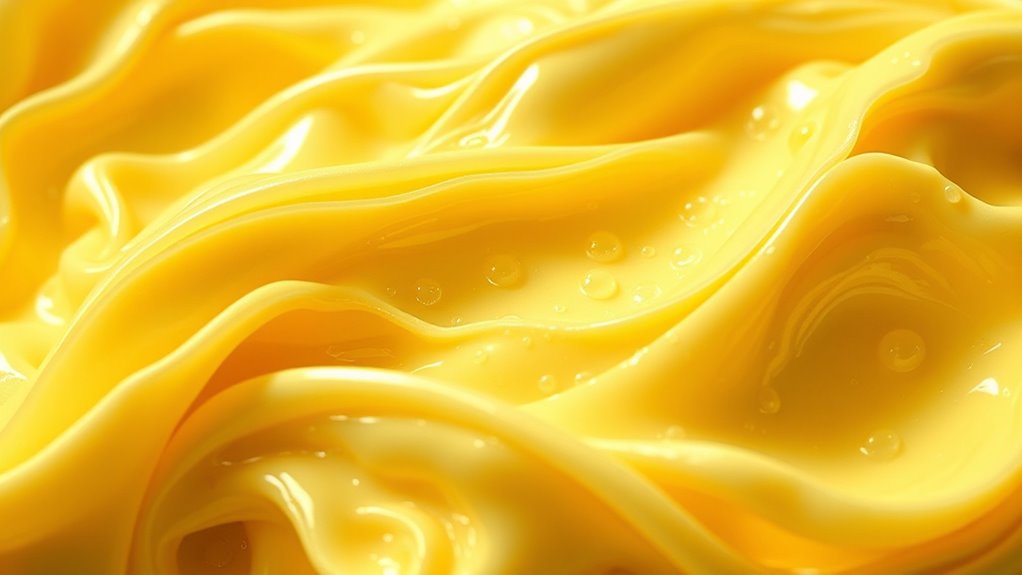
Vegan “butters” are crafted from a blend of plant-based fats, emulsifiers, and flavorings designed to mimic the creamy texture and rich taste of traditional butter. These products often prioritize sustainable ingredients, sourcing oils and fats that reduce environmental impact. When choosing vegan butters, you’ll notice allergen considerations are essential; many brands avoid common allergens like soy and nuts, making them suitable for sensitive individuals. Some formulations use coconut or sunflower oil, which are generally well-tolerated, but always check labels if allergies are a concern. The emulsifiers help create a smooth, spreadable consistency, while flavorings enhance that familiar buttery taste. Understanding these components helps you pick options aligned with your dietary needs and environmental values, ensuring a versatile addition to your plant-based kitchen. Additionally, eye patch benefits can be relevant when considering self-care routines that complement a healthy lifestyle.
The Laminating Process With Plant-Based Alternatives
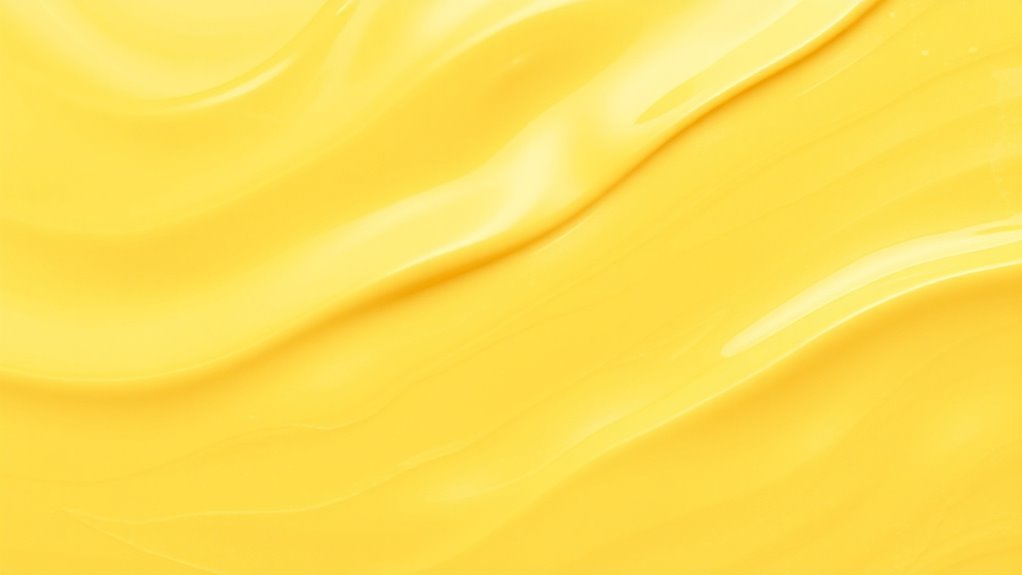
The laminating process with plant-based alternatives involves layering thin sheets of vegan “butter” between pastry or dough to create flaky, tender textures. Dairy substitutes like vegan “butter” are essential for achieving the right consistency and flavor. To guarantee success, you need to master specific baking techniques, such as chilling the dough and vegan butter, to keep layers distinct. Properly folding and rolling the dough allows the vegan “butter” to spread evenly, forming thin layers that puff during baking. This process mimics traditional laminating methods, relying on the solid fat’s ability to create steam and lift layers. With careful handling and attention to temperature, you can produce pastries with a flaky, buttery texture using plant-based substitutes.
Comparing Texture and Flakiness: Vegan vs. Traditional Butter
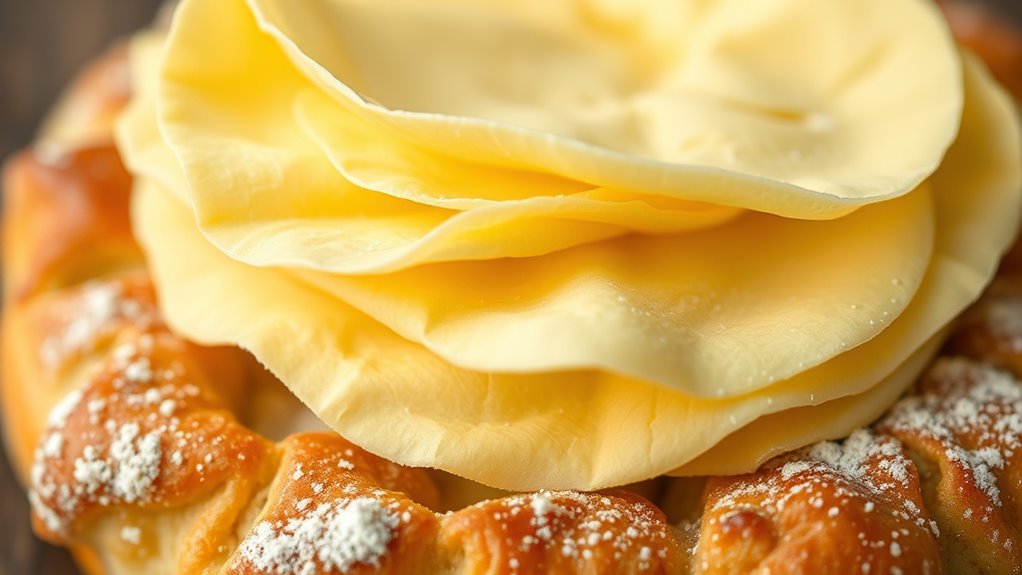
When comparing vegan and traditional butter, you’ll notice differences in flakiness and layer formation. Vegan options aim to replicate the same flaky, multi-layered texture that butter provides. Understanding these similarities and differences helps you achieve the perfect lamination in your baked goods. Additionally, the contrast ratio of your ingredients can influence how well the layers hold, impacting the overall texture and appearance of your pastry.
Flakiness and Layers
Achieving the perfect flaky layers in pastry depends heavily on how fat interacts with the dough. When using dairy substitution options like vegan butters, it’s vital to consider how these fats behave during pastry layering. Traditional butter creates distinct, crisp layers because of its water content and melting properties, which create steam and lift the dough. Vegan “butter” options vary in fat composition, affecting flakiness—some may produce softer layers or less separation. To mimic classic texture, you need to manipulate the dough carefully, ensuring even distribution of fat and proper folding techniques. Proper pastry layering relies on maintaining cold ingredients and handling the dough minimally to preserve those delicate, flaky strata that define a well-made laminated pastry. Understanding fat behavior can help optimize the flakiness and achieve a more authentic texture with vegan alternatives.
Texture Similarities
Vegan butters have made significant strides in mimicking the texture of traditional butter, but subtle differences still impact the final flaky layers. While dairy free spreads now offer improved pastry textures, they often lack the exact richness and melt-in-your-mouth feel of dairy-based butter. You might notice slight variations in how they fold or puff during baking. Incorporate natural materials such as coconut oil or palm oil to better replicate the fat content and structure of dairy butter, which can enhance lamination results. To compare: – Dairy free spreads can sometimes be softer or less firm, affecting lamination. – The flakiness may be less pronounced if the vegan butter doesn’t hold its shape well. – Texture differences can influence how evenly layers separate. – Achieving the same crispness and golden color requires adjustments in baking. Despite these challenges, many find vegan options suitable and increasingly comparable for laminated pastries.
Flavor Profiles and Richness in Vegan Laminates
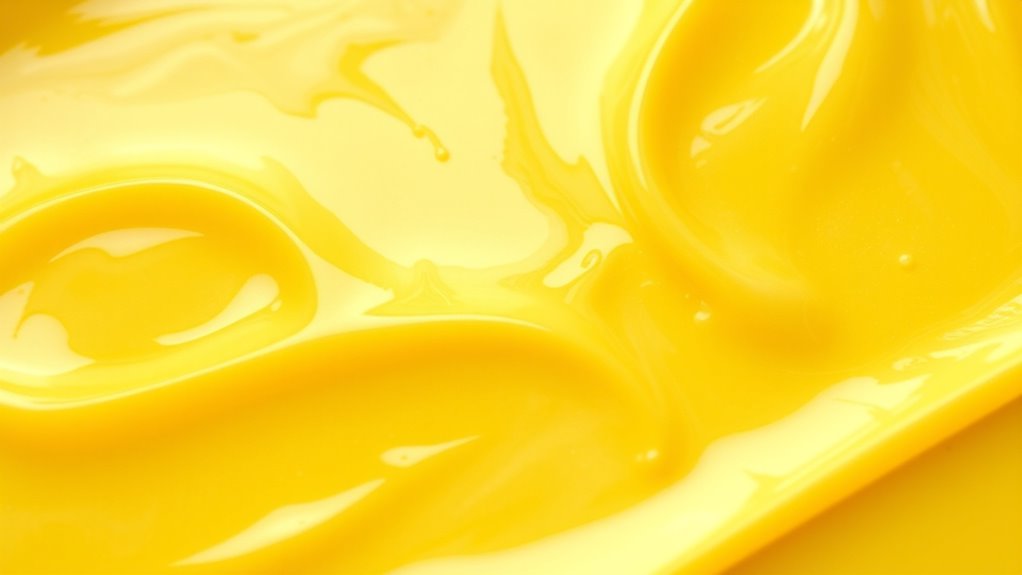
You’ll notice that vegan laminates can develop rich, layered flavors that add depth to your baked goods. The creaminess and mouthfeel also play a key role in making each bite satisfying. Exploring these flavor profiles helps you create more delicious and nuanced vegan pastries. Incorporating texture-enhancing ingredients can further elevate the overall sensory experience of your vegan laminates.
Flavor Depth and Complexity
The flavor depth and complexity of vegan butter laminates hinge on the careful balance of ingredients and techniques used during preparation. Achieving rich, layered flavors involves selecting ingredients that contribute both nutritional content and taste nuances. Incorporating affinities like nutritional yeast, toasted nuts, or subtle spices can enhance complexity. Proper fermentation or aging can deepen flavor profiles while maintaining shelf stability. Additionally, understanding dog breeds can inspire the selection of complementary ingredients that echo natural, wholesome flavors, adding another layer of complexity.
Creaminess and Mouthfeel
Achieving a creamy, smooth mouthfeel in vegan butter laminates hinges on selecting the right fats and emulsifiers to mimic the richness of dairy. High-quality plant fats like coconut or palm kernel oil help create that luscious texture, while emulsifiers such as lecithin improve smoothness and stability. Pay attention to the nutritional content, ensuring your ingredients provide sufficient fat for creaminess without excess saturated fats. Proper storage techniques are essential; keep your laminates refrigerated to maintain texture and prevent spoilage. Consistent storage preserves the mouthfeel and prevents texture degradation over time. Using the correct low carb foods ensures your vegan laminates remain rich and flavorful without unnecessary additives. By balancing fats and using effective storage methods, you can achieve a rich, creamy experience that rivals traditional butter, elevating your vegan laminates’ overall flavor profile and mouthfeel.
Common Challenges and How to Overcome Them
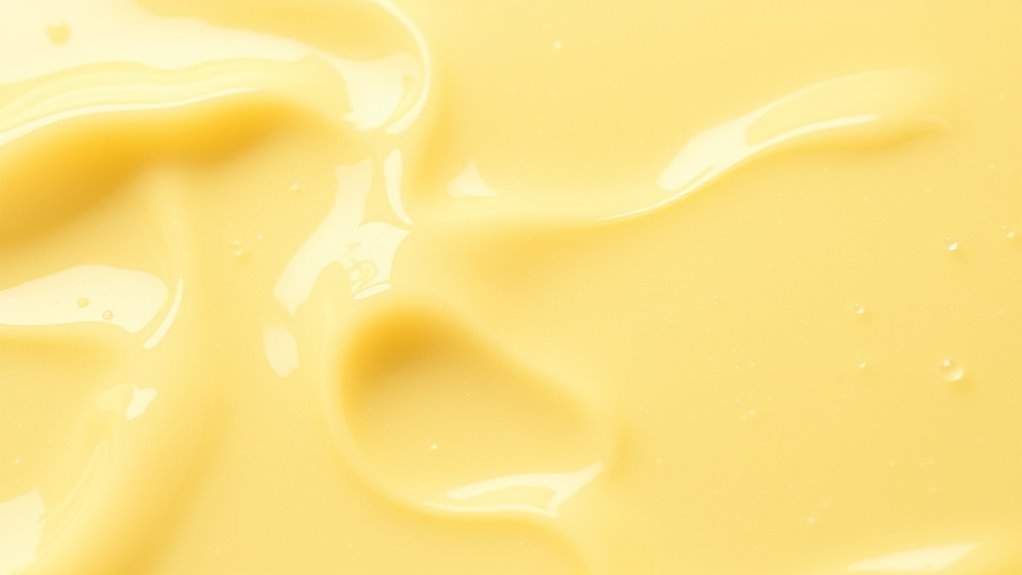
Despite the excitement around vegan “butter” laminates, several common challenges can disrupt your process. One issue is inconsistent layering, often caused by improper dough handling or temperature fluctuations. Using dairy free alternatives with the right fat content is essential, as some plant-based fats don’t behave like traditional butter. Baking science plays a key role in understanding how ingredients interact, helping you optimize lamination. You might also struggle with cracking or tearing, especially if dough isn’t chilled properly. Additionally, achieving the desired flaky texture can be tricky without the right balance of moisture and fat. To overcome these challenges, focus on maintaining consistent dough temperature, select suitable dairy free fats, and apply proper lamination techniques based on baking science principles. Incorporating differentiated design options like unique textures and materials can help improve the overall quality and appeal of your vegan “butter” laminates.
Tips for Achieving Professional-Quality Vegan Laminates
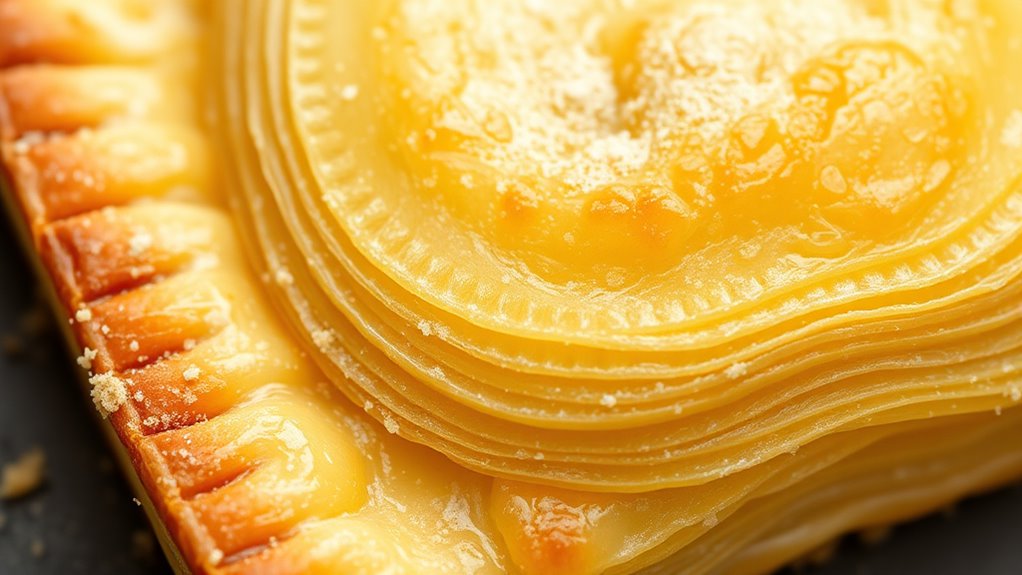
To produce professional-quality vegan laminates, focus on mastering key techniques that guarantee even layering and crisp, flaky textures. Start by selecting high-quality dairy free alternatives that mimic the richness of traditional butter, ensuring a tender, flaky result. Use precise baking techniques, such as chilling the dough thoroughly before rolling and folding, to create distinct layers. Keep your dough cold throughout the process to prevent melting and maintain lamination integrity. Properly roll and fold the dough multiple times to build layers without overworking it. Pay attention to even spacing and thickness during rolling, which helps achieve uniform layers. Additionally, understanding Self Watering Plant Pots can inspire innovative ways to maintain consistent moisture in baked goods, highlighting the importance of controlled environments in achieving perfect textures. With practice, these techniques will help you replicate the classic texture and appearance of traditional laminated pastries using vegan ingredients.
Frequently Asked Questions
Can Vegan Laminates Be Used for Savory Pastries or Only Desserts?
You can definitely use vegan laminates for savory pastries, not just desserts. Dairy alternatives like vegan butter work well, offering pastry versatility for both sweet and savory dishes. This means you can create flaky, delicious savory pastries such as spinach puffs or vegetable strudels with ease. The key is choosing the right vegan butter that melts and layers similarly to traditional dairy-based options, ensuring your savory baked goods turn out perfectly flaky and tasty.
How Long Do Vegan “Butter” Laminates Stay Fresh?
Think of vegan “butter” laminates as delicate pastries that need careful nurturing. Typically, their shelf life is about 3-5 days when stored in an airtight container in the fridge. To preserve their flaky layers, use proper preservation techniques like wrapping tightly and keeping them cool. If you want to extend freshness, consider freezing, but be mindful that texture might change. Enjoy them while they’re at their crisp, buttery best!
Are There Specific Brands That Produce the Best Vegan Laminates?
When choosing plant-based alternatives for vegan pastry options, certain brands stand out for their quality. You might find that brands like Miyoko’s or Earth Balance offer the best vegan laminates, providing a flaky, buttery texture similar to traditional options. These brands prioritize quality ingredients, making it easier to achieve that classic pastry look and feel. Experimenting with different brands helps you discover which one best matches the texture you’re aiming for.
What Are the Best Storage Methods to Maintain Vegan Laminate Quality?
To keep your vegan laminate fresh and maintain its quality, focus on proper refrigeration techniques. Store it in airtight storage container options to prevent moisture and air exposure, which can cause spoilage. Place the laminate in the coldest part of your fridge, ideally wrapped tightly or in a sealed container. Avoid frequent temperature changes, and consume within recommended timeframes to preserve its texture and flavor.
Can Vegan Laminates Be Customized for Different Flavor Infusions?
You can definitely customize vegan laminates for different flavor infusions by experimenting with ingredient variations. Incorporate herbs, spices, or nutritional yeast to add savory notes, or blend in fruit purees or extracts for sweeter options. Adjust the base ingredients to achieve your desired flavor profile, and guarantee proper mixing for even distribution. This flexibility allows you to create unique, delicious vegan laminates tailored to your taste preferences.
Conclusion
Mastering vegan lamination is like sculpting a delicate jewel—you need patience, precision, and the right ingredients. With a keen eye for texture and a few expert tips, you can craft vegan “butter” laminates that shine with flaky, rich layers. Keep experimenting and refining your technique, and soon you’ll create plant-based pastries that rival their traditional counterparts. Remember, every flaky layer you build brings you closer to bakery-quality perfection—your vegan masterpiece is within reach!
